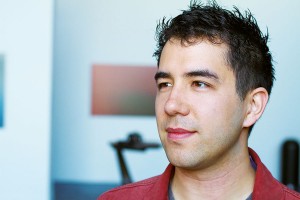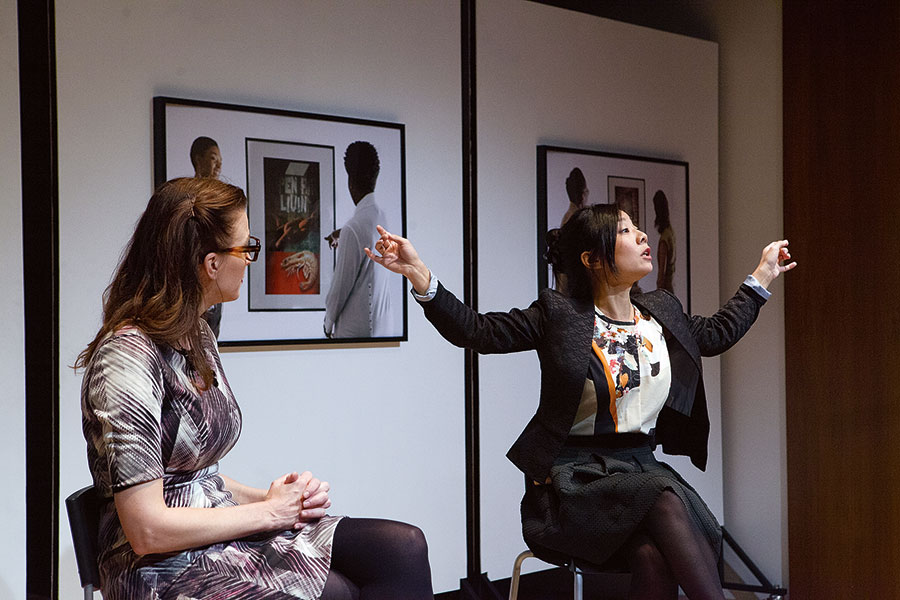The February 2016 print issue of American Theatre contains the complete playscript for Caught by Christopher Chen. The play premiered at Philadelphia’s InterAct Theatre Company in 2014 and will play at the Play Company in New York City in fall 2016. The play is a surprising exploration of the malleability of truth in artistic pursuits. [Spoiler alert: The following interview reveals many plot points from the play.]

As a preface to the published play (available in print and digital edition only), Chen had a conversation with Marissa Wolf, director of new works at Kansas City Repertory Theatre. Chen met Wolf when they were both new to the Bay Area theatre scene and trying to figure out where they belonged in the ecosystem. When Wolf became artistic director of Crowded Fire Theater in San Francisco, she commissioned Chen to write The Hundred Flowers Project, a critically acclaimed work that put Chen’s career on the map. The two spoke recently about Caught.
MARISSA WOLF: Can you talk about what drew you to Mike Daisey and others like him who have been publicly called out for fabricating their personal narratives?
CHRISTOPHER CHEN: I’ve always been kind of obsessed with fabrication scandals—James Frey, Jonah Lehrer, Jayson Blair. Mike Daisey is not on that scale, but he still kind of falls in that scandal milieu. And those scandals hit close to home in a way. Because, as a fiction writer, if I’m tackling a real-life subject matter, a question that always bedevils me is: What is my responsibility to the hard truth, and what is my responsibility to crafting a compelling narrative? It’s a question I’m afraid of. And you’re always drawn to things that you’re afraid of. I was drawn to Jurassic Park as a teenager because I was scared of the raptors. As a playwright, I have this kind of primal fear of letting down the truth in the search for greater truth.
When I went to China in 2009 to work on Into the Numbers, which was produced at the Beijing Fringe Festival, I visited 798 Art District. It’s a district that is devoted solely to Chinese contemporary art, and I was so taken aback when I walked through its streets because they seemed to be filled with politically provocative art, which went against my preconceptions of what the Chinese government would allow for public display. Afterwards, I did a little digging, and I found out that the original artists who founded the district have long since been evicted, and they were critical of their current government at the time. And in their place comes art that’s critical of something that’s safer to be critical of—namely, Mao’s older government. I concluded that it’s like a dam or a levee: You allow in a little bit of subversion for the goal of a greater means of control.
So what that indicated to me was, this is a fabrication too. Whatever you see on the surface, no matter how radical it might seem, you’re just seeing a surface thing, and there’s going to be layers below the surface.
I didn’t realize that what you’d written about that district in the play is real! But the way you encountered it feels so much like how an audience encounters your work. Can you talk about how you envision that relationship between the audience and the piece that you’re creating?
If the goal of a play is to challenge the audience to see things in a different light, and go on a personal journey for themselves in the process, then for me it’s a matter of taking into account that audiences come in with a certain frame of mind. So, for a lot of my plays, my first impulse is to acknowledge where they’re coming in from first, before pulling the rug out from under their feet. And I don’t see that as a gimmick, like, “Oh, I tricked you! See how smart I am!” When you go to a magician’s act, for example, the magician has a very welcoming relationship with the audience. He or she is going to pull the rug out from under an audience’s feet, and the audience is expecting that and is waiting for it. The sleight of hand operates in a very specific way in that you set up a certain expectation and then you dash it, and in the dashing process, that’s where the true light bulb will go off.

What did you glean from the audience’s relationship to the production when it premiered at Interact?
Initially I was scared because I got feedback from certain people who had read the play, and they intimated that they didn’t know if the audience would like to be tricked like this. And that’s totally fair because I don’t necessarily like to be tricked by unearned trickery. So the most affirming thing was that people seemed very gleeful by each twist the play took. One of the fears I had while writing this was: Well, the play just has too many twists; audiences are not going to be on board for the long haul. And yet, my observation of audience members was that by the time the second and third twists occurred, they were in on the joke, and were then delighted at being “fooled” one more time. It was fun, writing this piece, trying to anticipate audience reaction every step of the way, and calibrating to that. For example, if the first twist is meant to shock, and if the primary question for the audience associated with that shock is: “What reality are we in?’’ then after the second or third twist, the audience won’t be shocked in the same way, and would probably be irritated if the “what reality?” question still remained the question; eventually, they won’t care. So the question has to change. So after the second or third twist, the question changes to: “What is the play up to?” The goal of the play changes within the play itself, and it seemed like audiences latched onto this in the right way, they seemed hooked by the constant paradigm shifts. It starts out: This is a play about Chinese oppression. Oh, actually this is a play about fabrication and plagiarism. Oh, actually it’s a play about cultural appropriation. So then the journey becomes: What’s this sneaky play up to? Where’s the meaning going to lie?
I’m writing that down. “What’s this sneaky play up to?”
I grew up in California, so of course I casually read Buddhism. Another influence was The Diamond Sutra. The text is a dialogue of constant questioning. The teacher continuously challenges the student to question everything, even to the point where he’s questioning the teaching, and questioning the questioning.
Let’s talk a little bit about your relationship to China. For yourself as a young Asian-American writer with a Chinese dad and a white American mom, where do you see yourself within this world?
I’ve always had a complicated relationship with my ethnic and cultural heritage, because I am half and half. On the one hand, I very much identify with my white side, culturally. But at the same time, I also identify as a person of color, at least in part because of my last name. Because of that, a lot of my work deals with shifting perspectives of one culture to another: The American perceptions of China and the Chinese, and the Chinese or Chinese-American journey through America, and how perceptions of them affect them psychologically, even down to the subtlest nuances.

It seems like you’re investigating the relationship between China and America and particularly the white American fascination with and anxiety around China.
Right now I think America’s in this strange place of competition and awe of China, with definite echoes of the Cold War. I’m always interested in America’s relationship to other cultures: the preconceptions that are layered upon other cultures and how narratives are formed because of that. And I do have personal questions about my own conceptions of China, and how much ownership I have over the subject matter, given that my identity is very fluid and mixed. If I write about China—well can I do that? I’m not from China, so that’s multiple degrees removed from the actual country where my dad is from. I have genuine questions about what the right way of engaging with other cultures is, but I think that fits into a larger question of what your surface reality is, and how other cultures, among many other things, combine to form a very specific world view.
Something I was picking up on in Caught is this question around “authenticity of voice” and who is allowed to speak with authority on China, on Chinese artists, on Chinese prisons, on repression. And I love the way that you wrestle with that question.
And in one sense I don’t want the play to answer that question. I really hate the idea of a play having a definitive meaning. If this play were advocating for anything, it would be that to be a political actor you need to always be in the state of questioning and challenging yourself. It’s tough because, in a way, the play represents my own journey down a neurotic rabbit hole of: What’s authentic? What’s left, if everything you thought was authentic can be questioned? My answer to that is, what’s left is the process, the journey itself, the wrestling. So that is what is. That’s a comment on the transience of life. Nothing is permanent.
Marissa Wolf is the director of new works at Missouri’s Kansas City Repertory Theatre.


